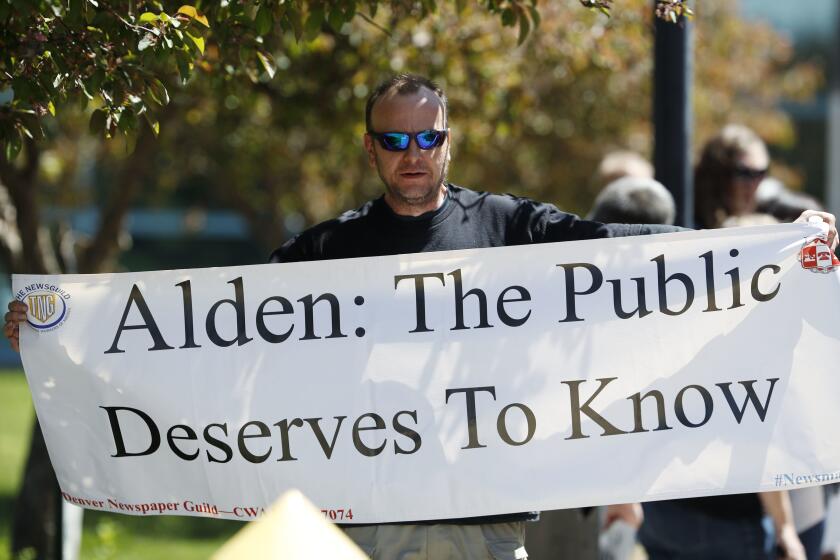Commentary: Where’s the love for the supreme Diana Ross?
Diana Ross has never won a Grammy.
Though nominated 12 times for her work with the Supremes and for her solo efforts, the singer behind pop classis such as “Baby Love” and “Upside Down” has never taken home the award.
This Saturday, she will be presented with a Lifetime Achievement Award by the Recording Academy along with Gil Scott-Heron, the Allman Brothers, Glen Campbell, George Jones, Antonio Carlos Jobim and the Memphis Horns, at an invitation-only ceremony the night before the Grammy telecast. Given her stature and the unmatched breadth of her work, it seems a wan consolation prize.
FOR THE RECORD:
Berry Gordy: An earlier version of this online article made reference to a supposed romance between Diana Ross and Berry Gordy. The word “supposed” should not have been used.
But the Grammys aren’t the only place where 67-year-old Ross, a primary architect of modern pop culture over her five-decade career, has been undervalued.
It’s long been fashionable to lampoon her in the media and in critical circles, to dismiss her voice and her trailblazing accomplishments — to cast her in the one-note role of incorrigible diva.
The books “Dreamgirl: My Life as a Supreme” by Mary Wilson and “Call Her Miss Ross” by J. Randy Taraborrelli often paint her as a dragon lady, detailing her thorny relationships with the Supremes, romance with Motown founder Berry Gordy, and haughty offstage behavior while shortchanging her accomplishments and work ethic.
PHOTOS: Famous artists who haven’t won Grammys
The unfavorable perceptions have seen Ross dismissed in ways that other legendary artists who’ve been passed over for a Grammy (the Who, the Beach Boys, Led Zeppelin, Queen) have not.
The late Marvin Gaye, Ross’ Motown contemporary and label mate, was vocal about his jealousy over attention she received from the label, but he also gave her due props.
“Diana’s about business,” Gaye told biographer David Ritz in “Divided Soul: The Life of Marvin Gaye.” “She’ll out rehearse you, out dress you, and outperform you, so you best stay out of her way. I appreciate Diana’s trip and her talent. She’s worked hard for everything she’s achieved.”
R&B singer Ledisi, nominated for three Grammys this year for her album “Pieces of Me,” is often compared to Aretha Franklin, Chaka Khan and Ella Fitzgerald, but says that Ross is one of her biggest influences.
“She made little girls dare to dream once they experienced her songs or films,” says the singer. “And of course, I was one of them — a shy, skinny, awkward, big-eyed, brown girl watching ‘Lady Sings the Blues’ for the first time at a friend’s house on a plastic-covered sofa. I remember thinking, ‘Wow, look at that white suit with that hat, and those red lips.’ Her version of ‘Our Love Is Here to Stay’ made me fall in love with jazz and Billie Holiday. I wanted to be like her.”
Yet the artistry and work ethic that impressed Gaye and inspired Ledisi are qualities that have received short shrift over the years. One reason may be that, despite all the ground Ross broke, she never fit neatly into existing expectations — artistically or in terms of race.
The genre-hopping in which she and fellow Supremes Wilson and Florence Ballard engaged in during the ‘60s saw them supplement their Motown hits with show tunes, pop standards, covers of the Beatles and Sam Cooke, and even a country and western album.
That gave way to Ross recording solo material by Ashford & Simpson while fluidly covering Laura Nyro, Stevie Wonder, John Lennon and Marvin Gaye, among others, and acing Broadway show tunes from the likes of “Pippin” and “A Chorus Line.”
She added jazz and disco to her repertoire, mastering both, receiving an Academy Award nomination for her portrayal of Billie Holiday in the 1972 film “Lady Sings the Blues” and a Grammy nomination for the disco classic “Love Hangover.”
Professor Daphne A. Brooks, who teaches English and African American Studies at Princeton, and is working on a book titled “Subterranean Blues: Black Women and Sound Subcultures — from Minstrelsy through the New Millennium,” says that Ross’ failure to conform to expectations cost her.
“Black cultural critics [and] white rock critics are trafficking in all sorts of presumptions about black authenticity politics when they dismiss the work of Ms. Ross and the Supremes,” says Brooks. “In other words, are we limiting our definitions of black culture when we fail to recognize the interracial and multicultural influences that have historically shaped black popular music culture — dating all the way back to the post-bellum Fisk Jubilee Singers? The music of Ms. Ross and the Supremes challenges us to think expansively about the dimensions of black popular music.”
Gaye said bluntly in “Divided Soul,” “If she had been white like Barbra Streisand, it would have been one hundred times easier for her. Even with Berry’s help, she hasn’t reached Streisand’s position, though she deserves it.”
Questlove, drummer and co-founder of the Roots, suggests that the failure to recognize Ross’ achievements is also due to the way art and artists are treated in this country.
“America is such a disposable arts culture,” he says, “that it’s easy to dismiss things, to take them for granted. And I’m one of those guilty people. I have every [Ross] album. I’ve seen every special. But you take it for granted so much that you don’t even mention it.”
Yet artists such as Questlove have been deeply inspired by Ross, to the point where her influence seems almost innate. “There was a turntable next to my bed when I was a kid,” says Questlove, “and at my bedtime, my parents would put two or three records on that would kinda take me to sleep. Side 2 of ‘An Evening With Diana Ross,’ where she does the Broadway stuff, Harry Nilsson’s ‘Me and My Arrow,’ and tells stories — that was my favorite moment. It was a major, major, major staple — that and the Marlo Thomas ‘Free to Be You and Me’ stuff she did.”
“You know,” he adds thoughtfully, “some people are just so larger-than-life that you don’t even count them as a major figure. They’re so ubiquitous that you take them for granted, like air.”
Visual artist Mark Bradford, a MacArthur Fellow whose career survey arrives at the San Francisco Museum of Modern Art and Yerba Buena Center for the Arts on Feb. 18, was inspired by Ross’ indomitable spirit. “She was a trailblazer who wrote chapter after chapter, who put herself at the center of the conversation and demanded a seat at the table,” he observes. “She didn’t want black power. She wanted power.”
“There’s this thing with women — especially women of color — that when they have ambition, it’s [perceived as] a character flaw” says Bradford. “But Diana Ross would throw it in your face. She didn’t apologize for it. We applaud ambition but on very narrow terms — for a woman, for an African American, and especially for an African American woman — and she ignored all those limited and limiting terms in order to set her own.”
Those terms, however, eventually redrew the blueprint for pop culture — and not just for women or African Americans.
“Without Ms. Ross,” says Brooks, “the ‘80s era of Whitney, Mariah and Madonna — not to mention Michael Jackson and Prince — and the ‘90s and ‘00s eras of hip-hop soul, neo soul and retro-soul women, would surely look quite different.”
Ernest Hardy is a Sundance Fellow and author of the books Blood Beats Vols. 1 and 2. His cultural criticism has appeared in the New York Times, Village Voice, L.A. Weekly, Millennium Film Journal, Rolling Stone, and the L.A. Times. He’s currently working on Blood Beats Vol. 3 and a collection of poetry and short stories.
More to Read
The biggest entertainment stories
Get our big stories about Hollywood, film, television, music, arts, culture and more right in your inbox as soon as they publish.
You may occasionally receive promotional content from the Los Angeles Times.










